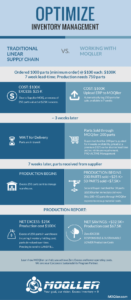“My mama always said, life is like a box of chocolates. You never know what you’re gonna get”— Forrest Gump, 1994. In the movie, Mama (played by Sally Field) uses this analogy to explain to Forrest how life is unpredictable. In reality, we do know what we’re “gonna get” when we buy a box of chocolates or any products. We also know the expiration or use-by date and when and where it was made. As important as knowing what we’re getting, we need to be able to trace back to when it was made. This information is referred to as batch code or date code.
Similarly, in electronics components, the date code indicates the manufacturing date. There is a standard published by the Electronics Components Industry Association (ECIA) that requires a four-digit date code marking on the components. Following the standard becomes impossible when the component size is shrunk to smaller than a grain of rice. According to the ECIA, the date code is marked with the four digits (YYWW); the first two digits stand for the last two digits of the year, and the last two digits are for the number of weeks. When date code marking is not possible, then it falls on the manufacturers to define the format and where customers can get that information. This results in a different format for different manufacturers.
Why the need for traceability?
“Today, more than ever, customers require component traceability back through the supply chain to the manufacturer as part of their counterfeit prevention policies” — ECIA guidelines. The counterfeit problem has exploded in recent years due to the shortage of parts in the market as demand grows and the sophistication of the counterfeiters.
During my years as a manufacturing engineer, part of failure and root cause analysis was to look at the date code of the components to figure out if there is a trend. Using date code information as part of the analysis, it helped to isolate the product failures due to defects during component manufacturing, during the assembly process, or inherent in the customer product design.
“Moreover, date codes may be contributing to one of the supply chain’s biggest problems: excess or obsolete inventory,” according to Barbara Jorgensen. “Components are rarely, if ever, consumed immediately by end customers. Finished products may sit on a warehouse shelf for months or even years. Date codes can expire if components aren’t moving.” (Are Electronics Date Code Practices Obsolete?, EPSNews, August 8, 2017.)
Also, electronics components degrade over time. Some Electronics Manufacturing Services (EMS) companies mandate not to use any components with date codes that are older than 2 years. This is due to the solderability issue. If this catches on and guidelines are established, there will be a lot of excess inventory to be scrapped to landfill. This is conflicts with our global plan in the circular economy to prevent E-waste.
Solving the date code problem
Perhaps advancements in technology like Blockchain will allow us to trace the component supply chain without the need to mark on the component, solving all these issues. But for now and in the immediate future, date code is our only way to trace electronics components as they make their way through the supply chain. With the COVID-19 pandemic, companies are beginning to understand the need to collaborate with others in a sharing ecosystem — an ecosystem that allows excess components to be used efficiently rather than sitting on warehouse shelves. When excess components change hands often such that excess and obsolete inventory is eliminated, date code practices may not be important and therefore become unnecessary.



